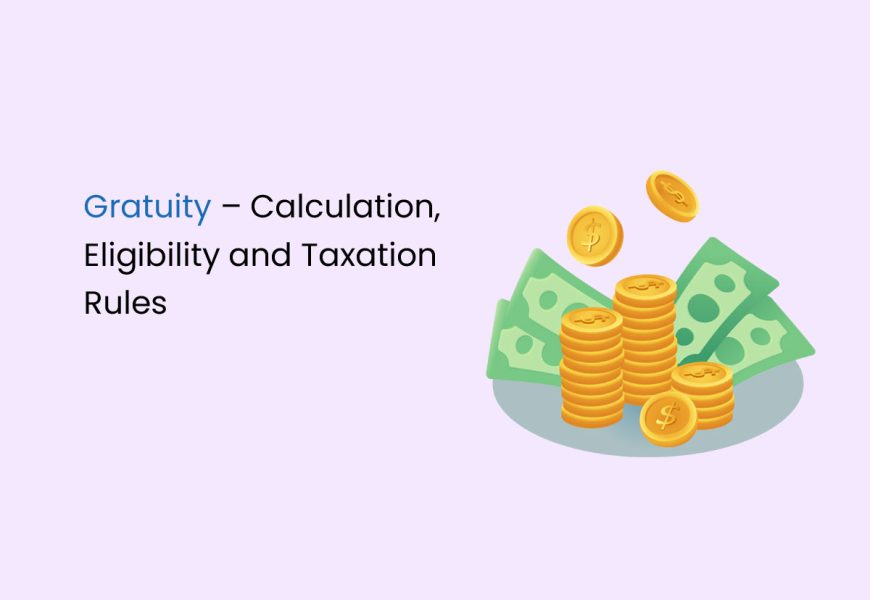In employment, compensation extends far beyond just monthly salaries or hourly wages. Among the multiple components of an employee’s total remuneration package, gratuity is just a small part. However, it is important in the grander scheme of things.
In this blog, we’ll discuss gratuity – its meaning, eligibility, calculation and taxation rules.
What is Gratuity?
Gratuity is a lump sum payment an employer provides their employees as a token of appreciation for their dedicated service to the company. However, only employees the company has employed for five or more are given gratuity. The gratuity payment is governed by the Payment of Gratuity Act of 1972.
Latest Advancements in Gratuity
A significant development concerning gratuity for private sector employees is the increase of the tax-free gratuity amount from Rs.10 lakh to Rs. 20 lakh. Similarly, this adjustment was promptly made for central government employees following the introduction and execution of the 7th Central Pay Commission.
The Union Government has also proposed many security measures for the workforce in light of the global pandemic. In a press conference by Finance Minister Nirmala Sitharaman, it was announced that the government plans to offer the payment of gratuity after one year of service. This will apply to the fixed-term employees of a firm.
Eligibility Criteria for Gratuity
The following are the eligibility criteria to receive gratuity:
- When an employee is eligible for superannuation, a superannuation plan is a pension plan for a company’s employees.
- If an employee is retiring or resigning after four years and eight months of uninterrupted service.
- If an employee gets disabled or due to a disease, they can get gratuity before five years.
- The minimum employment period condition isn’t applicable if an employee dies due to serious illness. In this scenario, the nominee becomes the recipient of gratuity.
Gratuity Calculation
The gratuity amount depends on the number of years of service and the last salary drawn. The Payment of Gratuity Act of 1972 specifies the calculations for gratuity. The categories for gratuity calculation are:
Employees covered under the Act
The gratuity calculation formula is as follows:
N – Number of years of service in the company
B – Basic Salary including Dearness Allowance
For example, If an employee had drawn Rs. 70,000 for ten years of employment, then the gratuity amount as per the formula is:
Gratuity = 10 x 70,000 x (15/26) = Rs. 3,64,000

Employees not covered under the Act
Even if an organisation is not a part of the Act, they can pay gratuity to their employees. However, the gratuity calculation is determined by an individual’s half a month’s salary for each completed year, encompassing commission (based on sales), dearness allowance, and basic pay.
The gratuity calculation formula is as follows:
Gratuity = N x B x (15/30)
N – Number of years of service in the company
B – Basic Salary including Dearness Allowance
For example, If an employee had drawn Rs. 70,000 for ten years of employment, then the gratuity amount as per the formula is:
Gratuity = 10 x 70,000 x (15/30) = Rs. 3,50,000
In case of Death of an Employee
In case of the death of an employee, the gratuity is calculated based on the tenure of service of the employee. However, there is a cap not exceeding Rs. 20 lakh.
| Tenure of service | The amount payable towards gratuity |
|---|---|
| Less than a year | 2 x basic salary |
| One year or more but less than five years | 6 x basic salary |
| Five years or more but less than 11 years | 12 x basic salary |
| 11 years or more but less than 20 years | 20 x basic salary |
| 20 years or more | Half of the basic salary for each completed in six-month periods (subject to a maximum of 33 x basic salary) |
Some crucial points to keep in mind:
- If the number of months in the last year of service is more than six, it is rounded up. If the number of months in the last year of service is less than six, it is rounded down. For example, 19 years’ 7 months’ tenure is treated as 20 years, while 19 years’ 5 months is treated as 19 years.
- An employer can forfeit gratuity payment, wholly or partially, in case of any misconduct or act of violence of an employee.
Taxation Rules on Gratuity
The gratuity amount is taxable under the Income Tax Act. The tax exemptions vary between employees, depending on the employer and their coverage under the Gratuity Act.
Government employees are fully exempt from taxation on the entire gratuity amount.
Private-sector employees covered under the Gratuity Act can avail of the following tax exemption:
- The maximum limit of Rs. 20 lakh (amended from Rs. 10 lakh)
- Last drawn Basic Salary x Years of service x 15/26
- The actual gratuity amount received
Employees not covered under the Gratuity Act can avail of the following tax exemption:
- Half month’s average salary x years of service completed
- The maximum limit of Rs. 20 Lakh gratuity amount
- The entire gratuity amount received
Tax Exemptions on Gratuity
The tax exemptions on gratuity are as follows:
- According to Article 10 (10) of the Income Tax Act, gratuity received by government employees is fully exempt from tax.
- The death and retirement gratuity receivable by an employee covered under the Gratuity Act is exempt from tax:
- The maximum limit of Rs. 20 lakh (amended from Rs. 10 lakh)
- Last drawn Basic Salary x Years of service x 15/26
- The actual gratuity amount received
- The exemptions for gratuity received by employees not covered under the Gratuity Act are as follows:
- Half month’s average salary x years of service completed
- The maximum limit of Rs. 20 Lakh gratuity amount
- The entire gratuity amount received
Forfeiture of Gratuity
The Payment of Gratuity Act of 1972 states that an employer can withhold all or part of an employee’s gratuity payment, even after completing five or more years of service. This only applies when the employee has been fired for disorderly behaviour, which includes attempting to injure others physically while on the job.
Gratuity Payment
The three steps of gratuity payment are as follows:
- Initiation: An individual or a person authorised must apply to an employer regarding the gratuity a company owes them.
- Acknowledgement and calculation: The organisation that owes gratuity will compute the amount as soon as the application is received and will also send a notice to the person and the governing authority with the amount stated.
- Disbursal: The employer, having sent the acknowledgement, has 30 days to pay the gratuity amount to the individual.
Organisations eligible for Gratuity
Employers with ten or more employees are eligible under the Payment of Gratuity Act 1972. The organisations covered under the act are:
- Every manufacturing unit, mine, oilfield operation, plantation, port, or railway corporation.
- Every business or establishment, as defined by the law, where ten or more individuals have been employed at any time during the previous 12 months (specified by the State Government).
- Every business or establishment, as defined by the law, where ten or more individuals have been employed at any time during the previous 12 months (specified by the Central Government).
- Every shop or establishment regulated by the Gratuity Act that, after meeting eligibility criteria, has seen its employee count drop below ten.
Conclusion
Gratuity is more than just a financial transaction; it’s a token of acknowledgement for the dedication and hard work you’ve invested in your professional journey. For employers, it’s a legal obligation that, when fulfilled thoughtfully, fosters a positive work environment.
We at TankhaPay offer a robust and automated payroll service managing tasks such as salary calculations, gratuity calculations, tax deductions, and compliance reporting. Download the TankhaPay app today or visit www.tankhapay.com for more information.
Frequently Asked Questions on Gratuity
What is the maximum gratuity I can receive tax-free?
The exemption limit has increased to Rs. 20 lakh from the former Rs. 10 lakh.
How much time does an employer take to release the gratuity amount?
As per government norms, an employer has to pay a gratuity within 30 days of the total and final settlement of the employee. If the deadline is missed, the employer must pay the gratuity amount plus interest incurred from the due date to the actual payment date.
Will I lose the gratuity amount if my employer goes bankrupt?
The gratuity remains payable even if your employer faces bankruptcy.
Do contract employees receive gratuity after completing five years of service?
Contract workers are not entitled to receive gratuity.
Does gratuity go under CTC?
They are not a component of CTC.
How do I nominate someone to receive my gratuity?
When joining a company, you must fill in Form F to nominate one or more heirs for your gratuity amount.














